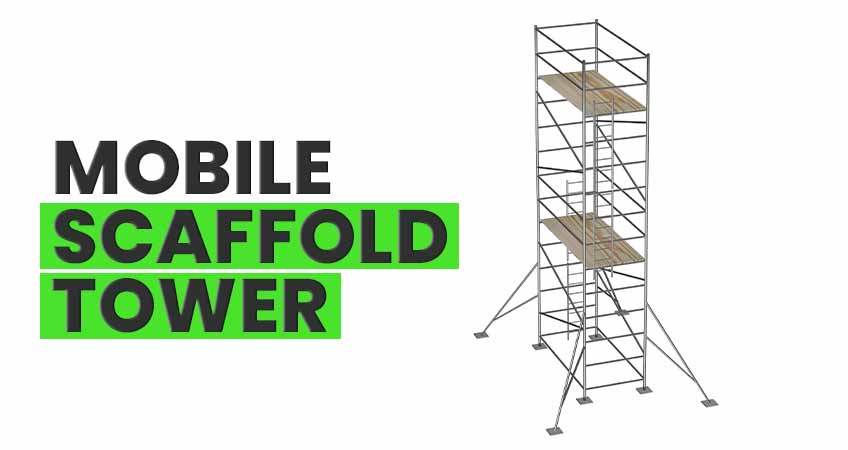Mobile scaffold towers are a game-changer in construction and DIY projects. Whether you’re a seasoned construction professional, a DIY enthusiast, or a home improvement expert, these versatile structures provide the height and stability needed for various tasks while offering unmatched flexibility.
But what exactly is a mobile tower scaffold, and how do you use it safely?
By the end of this guide, you’ll not only have a comprehensive understanding of mobile scaffold but also know when to use them for your projects.
What is a mobile scaffold tower?
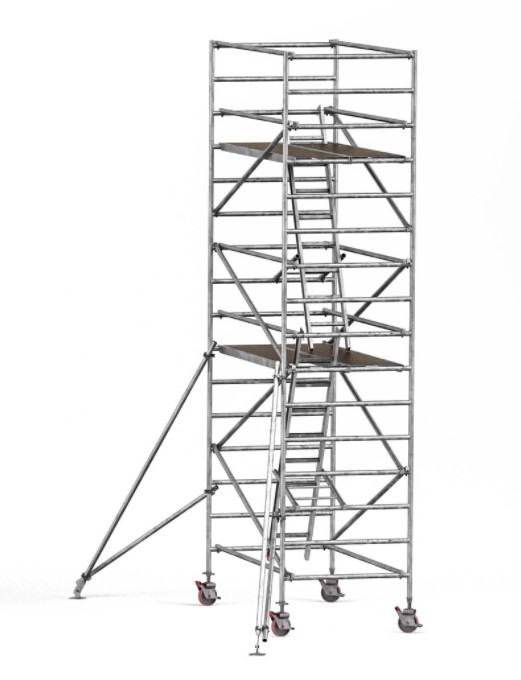
Mobile tower scaffold is one of the types of scaffolding structure mounted on wheels, making it easy to move from one location to another. These towers are widely used in construction, painting, maintenance, and home improvement projects where flexibility and convenience are essential.
Unlike fixed scaffold towers, mobile towers are designed for quick assembly and disassembly, allowing users to adapt to changing project requirements.
Key features and benefits of a mobile scaffold tower:
- Lightweight and portable: Typically made of aluminium for easy transport and assembly, whilst still providing a solid structure to work from.
- Modular design: Working platform can be adjusted to different heights based on project needs.
- Flexibility: Quickly adjust height and relocate the tower as required.
- Mobility: The wheel-mounted design makes it easy to move the tower without disassembly.
- Cost-effectiveness: Ideal for small- to medium-scale projects, eliminating the need for more expensive scaffolding systems.
- Ease of use: This access equipment is designed for quick assembly and disassembly, making it perfect for short-term tasks.
- Safety: Includes features like non-slip platforms, an advanced guard rail system, and to minimise risk and ensure tower stability.
Comparison with fixed scaffold towers
While fixed scaffold towers are ideal for long-term or large-scale projects requiring significant height and stability, mobile towers are perfect for short-term tasks that demand frequent movement. Fixed towers are anchored to the ground, providing maximum stability, while mobile towers prioritise flexibility without compromising safety. When choosing between them, it’s essential to consider the scaffolding cost for your specific project needs.
How high can a mobile scaffold tower go?
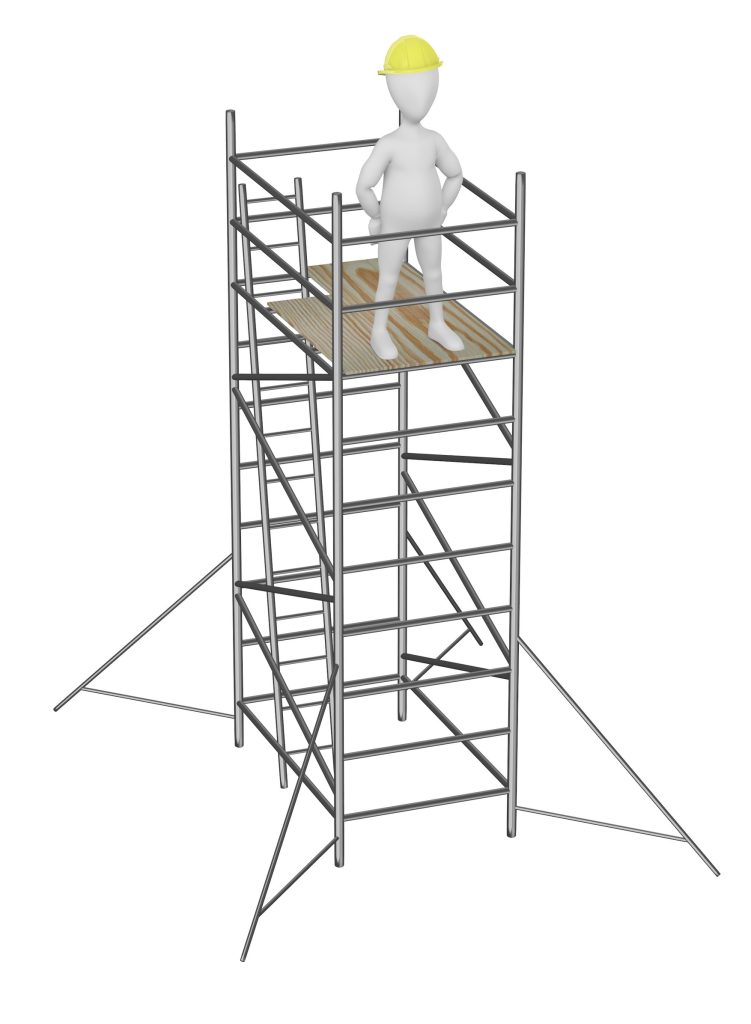
The maximum height of a mobile tower depends on several factors, including the design, material, and intended use. Most mobile towers can safely reach heights of up to 12 metres for outdoor use and even higher for indoor settings. However, it’s essential to follow manufacturer recommendations and adhere to safety regulations.
Factors determining maximum height:
- Material strength: Aluminium towers are lightweight and durable, but their load capacity and stability diminish at extreme heights.
- Base dimensions: A wider base provides better stability, allowing for greater heights.
- Stabilisers: Properly installed stabilisers increase the height limit by providing additional support.
- Weather conditions: Outdoor use in windy or uneven terrain reduces the safe height.
Safe height selection guidelines
- For every 3.5 to 4 metres in height, use stabilisers or outriggers to maintain stability.
- Always follow local guidelines, such as the Working at Height Regulations 2005 in the UK.
- Never exceed the manufacturer’s specified height limit.
Consulting scaffolding professionals like B-Mat Scaffolding ensures your project stays safe and compliant.
How to build a mobile scaffold tower
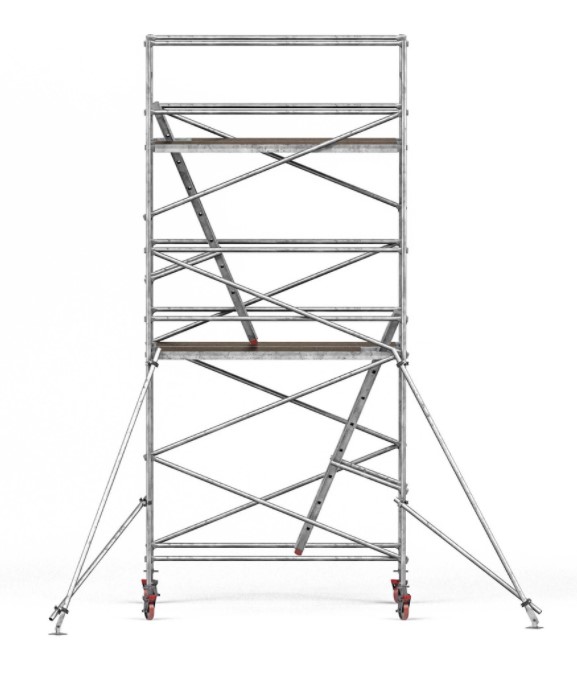
Constructing a temporary platform is not something that comes with an instruction manual, however building a working tower requires careful planning and adherence to safety best practices.
Follow this step-by-step guide for a safe and efficient setup:
Step 1: Prepare the site
- Ensure the ground is level, firm, and free of obstacles.
- Check weather conditions for outdoor projects; avoid assembling in strong winds.
Step 2: Lay the base
- Assemble the base of the tower and attach the lockable castor wheels.
- Double-check that the wheels are securely locked to prevent accidental movement.
Step 3: Add the frames
- Attach the vertical scaffold frames and secure them with the provided locking mechanisms.
- Use a spirit level to ensure the structure stays upright.
Step 4: Install platforms and guardrails
- Place the platform boards securely on the frame, ensuring they are level and stable.
- Attach the guardrails around the platform to prevent falls.
Step 5: Attach stabilisers or outriggers
- Install stabilisers or outriggers at the base for added stability, especially as the tower height increases.
Step 6: Inspect and test
- Perform a thorough inspection to confirm that all components are secure and safe for use.
- Test the structure for any wobbling before climbing.
Safety tips:
- Never exceed the weight limit specified by the manufacturer.
- Always climb using the built-in ladder or access points; never use the tower’s exterior.
- Wear personal protective equipment (PPE), including a hard hat and non-slip shoes.
The benefits of a professional scaffolding solution
For those without proper training or experience, it is strongly recommended to hire a professional scaffolding company for the setup and erection process.
Expert professionals possess the necessary skills, certified equipment, and safety protocols to ensure that the scaffolding is installed securely and meets all regulatory standards.
Relying on trained specialists minimizes the risk of accidents, structural failures, and potential injuries, providing peace of mind and a safer working environment.
Tasks that mobile scaffold towers are best suited for
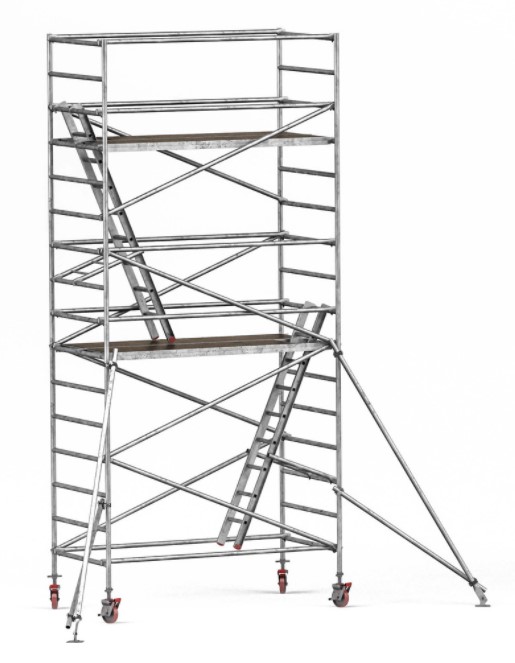
Mobile towers shine in tasks requiring versatility and access to elevated areas. Here are some scenarios where they excel:
- Painting and decorating:
Perfect for indoor and outdoor painting jobs, allowing easy movement to cover large surfaces.
- Electrical and HVAC installations:
Provide a stable platform for electrical wiring or installing air conditioning systems.
- Home maintenance:
Ideal for cleaning gutters, fixing roofs, or trimming tall hedges in residential projects.
- Signage and lighting setup:
Commonly used in events or commercial settings to install signage, banners, or lighting systems.
Conclusion
Mobile towers offer numerous advantages over traditional scaffolding systems, making them a popular choice for short-term and small- to medium-scale projects.
With their adjustable height, flexibility, mobility, cost-effectiveness, ease of use, and safety features, they are a valuable asset in any construction or maintenance project.
However, it’s crucial to follow guidelines and best practices when setting up mobile scaffold towers and consult professionals for safe installation. So whether you’re a DIY enthusiast or a seasoned professional, consider using mobile scaffold towers for your next project to reap these benefits. Happy scaffolding!
Save yourself the hassle with a professional mobile access tower from B Mat Scaffolding!
At B-Mat Scaffolding, we understand the importance of safety, efficiency, and quality when working at height. Our experienced professionals ensure that every scaffolding solution is tailored to your project needs, whether you’re a DIY enthusiast, a construction professional, or managing a home improvement project.
We offer:
- Expertise in mobile scaffold towers and all types of scaffolding solutions.
- High-quality equipment that meets industry safety standards.
- Friendly and reliable service to guide you through every step of your project.
Get expert advice today
Looking to hire a mobile scaffold tower or need professional advice? Contact B-Mat Scaffolding for a free quote and ensure your project runs smoothly and safely.


